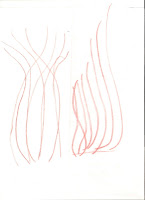“Large and Long is to Small and Tiny” is an explorative project about nature and our environment. Its dimensions span 12’ H x 12” W x 10” D. It is made up of CVP pipes for the internal structure and black satin ribbon for the exterior. For this project I was trying to show 2 different elements of nature that I explored throughout the quarter.
The first concept was the asymmetrical forms that are created by nature versus the symmetrical forms created by mankind. I found that asymmetry in nature required a process to be created and evolved out of organic events. (More detailed descriptions of these thoughts are located on my “Step 1 Final Project Blog) For this Final Project I really wanted to highlight this organic nature of asymmetry by using the internal structure of my form.
The second idea I wanted to convey during this project was more of a conceptual approach referring to the “micro creating the macro” (More detailed descriptions of these thoughts are also located on my “Step 1 Final Project Blog”).
While observing nature I realized that the micro is responsible for creating the macro which creates the forms we call nature. This dichotomy is represented in the title and the use of individual ribbons to form the macro of the triangular surface.
This project was a huge undertaking and challenge for me. I have never worked in such a large scale and have little knowledge of how to actually construct form using tools….I tend to be more of a scissor/construction paper kinda gal.
The process of this project required me to test my mental boundaries as well as my faith in my ability to construct something of my mind that was difficult to explain to others. I am proud of myself for my presentence and perseverance. I was glad that the end result combined the two concepts I was trying to convey. The project definitely made me more interested in working with large scale again sometime.

























